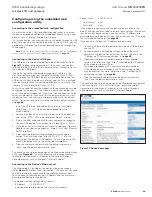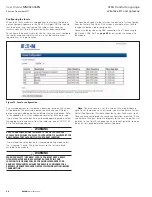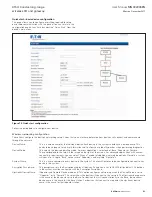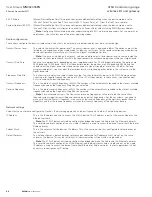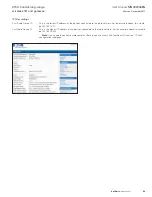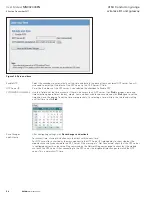
41
User Manual
MN032006EN
Effective December 2017
415U Condor-long-range
wireless I/O and gateway
EATON
www.eaton.com
Modbus TCP mapping examples
In the example in
Figure 63
, the first mapping (#1) shows the
Modbus client (master) is configured to read analog values from
a device connected on the LAN. The mappings function code is
“Read” and is reading a count of four values (analogs) from the
Ethernet address 192,168.0.17, device ID #10, starting at address
30001, and then writing these values into its own local registers,
starting at 40501. The server port is 502, which is a standard Modbus
TCP port address. If the mapping fails to communicate to the TCP
server, it will write a value of “1” into local register 508, indicating a
communications failure.
Figure 63. Modbus TCP mapping table
The second mapping (#2) shows something similar, but instead of
analog values, the values are digital. The Function code is “Read”
from IP address 192.168.0.17 and device ID #10. It will read eight
values starting from address 10001, and write them to the local
address, starting at 501. Again, it is using the same server port of
502. If the mapping fails to communicate to the TCP server, it will
write a value of “1” into local register 507, indicating that mapping
failed to communicate.
The third mapping (#3) is similar to the second mapping, but instead
of reading from the local Ethernet subnet (LAN) it is reading from
an IP address on the radio network (another 415U-2 module). The
Function code is “Read” from IP address 192.168.10.101 and device
ID #1. It will read four values, starting from address 10001, and write
them to the local address, starting at 509. A Comms Fail register is
configured at local register 506.
The fourth mapping (#4) is configured to write the values from the
local analog input #1 and #2 across to a TCP server at IP address
192.168.0.17. It will write the values into the destination address
40001 and 40002 at device ID of 10. It is using the TCP server port
502 and is configured with a response time of 1000 msec. If it fails
to communicate, it will turn on local register 505.
Modbus RTU master
Modbus RTU functionality allows connections to Modbus RTU slave
devices via the RS-232 or RS-485 ports. Up to 100 mappings can
be configured. All Modbus mappings are directed to or from the
onboard I/O registers depending on the configuration (described
below). The Modbus RTU master polls the slave devices via the
serial port configured in the mappings.
Modbus RTU (serial) devices can also be polled if connected to
remote 415U-2 serial ports. To enable this feature the remote 415U-2
serial port must be set to “Modbus RTU Master” mode and the
TCP mappings must reflect the correct server IP address and port
number of the remote 415U-2. Polling TCP servers or RTU slaves
over the radio network will greatly increase radio communications
and is not recommended for busy systems.
Example
The Modbus RTU mapping is very similar to the Modbus TCP
mapping except that the destination is a serial interface instead of an
Ethernet address and port.
In the example in
Figure 64
, the first mapping (#1) shows a read
mapping from a serial device connected on the RS-485 port with a
device ID of 5. It is reading one I/O point, starting at remote address
30001, and writing the value into the local address 40501. It is
configured with a response timeout of 1000 msec, and local register
508 will indicate a failure to communicate with this device.
Figure 64. Modbus RTU example
The second mapping (#2) shows a read mapping from a serial device
connected on the RS-485 port with a device ID of 5. It is reading
16 I/O points, starting at remote address 10001, and writing the
value into the local address 501. It is configured with a response
timeout of 1000 msec, and local register 507 will indicate a failure to
communicate with this device.
The third mapping (#3) is a write mapping that will write the
local battery voltage (Reg 30007) to register 40001 on a serial
device connected on the RS-232 with a device ID of 6. Again, the
response timeout is 1000 msec, and it has a communications fail
register of 506.























